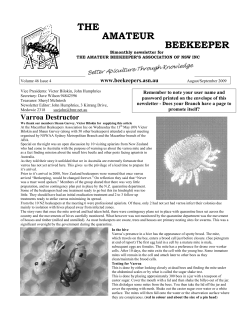
technical Classification
technical sheet Fur, Skin, and Ear Mites (Acariasis) Classification External parasites Family Arachnida Affected species There are many species of mites that may affect the species listed below. The list below illustrates the most commonly found mites, although other mites may be found. • Mice: Myocoptes musculinus, Myobia musculi, Radfordia affinis • Rats: Ornithonyssus bacoti*, Radfordia ensifera • Guinea pigs: Chirodiscoides caviae, Trixacarus caviae* • Hamsters: Demodex aurati, Demodex criceti • Gerbils: (very rare) • Rabbits: Cheyletiella parasitivorax*, Psoroptes cuniculi * Zoonotic agents Frequency Rare in laboratory guinea pigs and gerbils. Occasional in rabbits and rats. More common in mice. Almost universal in hamsters. Many of these mites are commonly found in wild and pet populations of the above species. Transmission Mites are transmitted by direct contact with an infested animal or the environment of that animal (bedding, incompletely cleaned cage). Clinical Signs and Lesions Fur mites live and breed on the fur, but descend to the skin to insert their mouthparts for a meal of plasma or to feed on epidermal cells shed by the host. Skin mites live in the skin or hair follicles. Mites are commonly found on the dorsum of affected animals, specifically between the scapulae, on the head, on the neck, or the flank. Animals with mite infestations have varying clinical signs ranging from none to mild alopecia to severe pruritus and ulcerative dermatitis. Signs tend to worsen as the animals age, but individual animals or strains may be more or less sensitive to clinical signs related to infestation. Mite infestations are often asymptomatic, but may be pruritic, and animals may damage their skin by scratching. Damaged skin may become secondarily infected, leading to or worsening ulcerative dermatitis. Nude or hairless animals are not susceptible to fur mite infestations. Humans are not subject to more than transient infestations with any of the above organisms, except for O. bacoti. Transient infestations by rodent mites may cause the formation of itchy, red, raised skin nodules. Since O. bacoti is indiscriminate in its feeding, it will infest humans and may carry several blood-borne diseases from infected rats. Animals with O. bacoti infestations should be treated with caution. Diagnosis Fur mites are visible on the fur using stereomicroscopy and are commonly diagnosed by direct examination of the pelt or, with much less sensitivity, by examination of plucked tufts of fur. Follicle mites (Demodex spp.) are detected by light microscopic examination of skin scrapings. Psoroptes cuniculi is detected by light microscopic evaluation of ear swabs, smeared onto a microscope slide. Light microscopy is usually used to speciate mites, as morphology of claws and body shapes are keys to speciation. Mites may also be diagnosed by euthanizing an animal and placing the animal or its skin on paper in a Petri dish or plastic bag, and then placing the sealed dish or bag in a cool place. Mites will then leave the animal to find a new host, and may be noted walking about on the paper. Rarely, mite eggs are ingested and found in the feces of the affected animal. Interference with Research Animals with mites and severe clinical signs such as ulcerative dermatitis are not suitable for use in research. technical sheet The zoonotic nature of some mites may also pose a health hazard to workers. Animals with inapparent mite infestations may still have sequelae that interfere with research. For example, mice with Myobia musculi acariasis may have an increased IgE response, an increase in the formation of secondary amyloid, hypoalbuminemia, and a decreased mean haemoglobin concentration. In hamsters, clinical signs are rarely associated with Demodex, and if seen, are usually related to advanced age or experimental manipulation. Thorough cleaning of all surfaces in contact with animals should serve to remove mites from the environment, although the literature does not discuss susceptibility to cleaning agents. Prevention and Treatment Fox JG, Anderson LC, Lowe FM, Quimby FW, editors. Laboratory Animal Medicine. 2nd ed. San Diego: Academic Press; 2002. 1325 pp. Since mites are transmitted by direct contact with infected animals, acariasis is prevented by quarantine (with adequate evaluation) or rederivation of all animals entering the animal facility. Since animals with just a few mites may reinfest an entire facility, even after quarantine, many facilities quarantine and treat at the same time. Wild or pet animals may also carry mites, and excluding these animals from the animal facility is important. References Baker DG. Natural Pathogens of Laboratory Animals: Their effects on research. Washington, D.C.: ASM Press; 2003. 385 pp. Baker DG, editor. Flynn’s Parasites of Laboratory Animals. 2nd ed. Ames: Blackwell Publishing; 2008. 813 pp. Fox J, Barthold S, Davisson M, Newcomer C, Quimby F, and Smith A editors. The Mouse in Biomedical Research: Diseases. 2nd ed. New York: Academic Press; 2007. 756 pp. Percy DH, Barthold SW. Pathology of Laboratory Rodents and Rabbits. 3rd ed. Ames: Iowa State University Press; 2007. 325 pp. Mites may be treated with a variety of compounds that vary in toxicity to the host. The most common treatments currently in use are ivermectin-family insecticides. Mite treatments are generally applied topically, although systemic treatments are described in the literature. Treatments may include an insecticide-permeated cotton ball placed in the cage, topical treatment of 1% ivermectin (oral sheep drench) between the scapulae, or 1% ivermectin diluted in water or water and proplylene glycol and sprayed on mice. The reader is advised to consult the literature or their veterinarian for further details. Newer ivermectins do not seem to be as effective as ivermectin. Care should be taken when treating transgenic mice, very young animals, or animals known to have blood-brain-barrier compromise. In many cases, treatment does not serve to eradicate the mites, and rederivation is used. © 2009, Charles River Laboratories International, Inc. Fur, Skin, and Ear Mites - Technical Sheet Charles River Research Models and Services T: +1 877 CRIVER 1 • +1 877 274 8371 E: askcharlesriver@crl.com • www.criver.com
© Copyright 2025





















